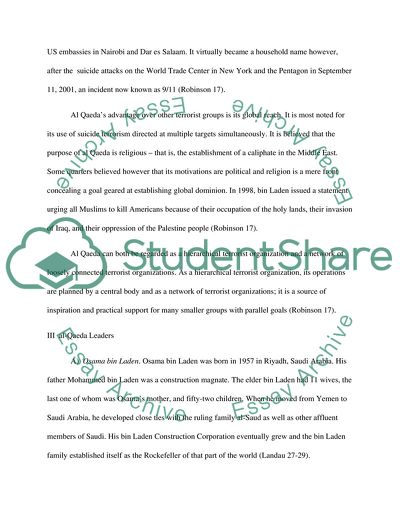Cite this document
(“The Al-Qaeda Terrorist Organization Essay Example | Topics and Well Written Essays - 2500 words”, n.d.)
The Al-Qaeda Terrorist Organization Essay Example | Topics and Well Written Essays - 2500 words. Retrieved from https://studentshare.org/social-science/1552849-discuss-the-al-qaeda-terrorist-organization-examine-at-least-three-terrorist-events-that-al-qaeda-is-thought-to-have-organized-or-been-involved-in-carrying-out
The Al-Qaeda Terrorist Organization Essay Example | Topics and Well Written Essays - 2500 words. Retrieved from https://studentshare.org/social-science/1552849-discuss-the-al-qaeda-terrorist-organization-examine-at-least-three-terrorist-events-that-al-qaeda-is-thought-to-have-organized-or-been-involved-in-carrying-out
(The Al-Qaeda Terrorist Organization Essay Example | Topics and Well Written Essays - 2500 Words)
The Al-Qaeda Terrorist Organization Essay Example | Topics and Well Written Essays - 2500 Words. https://studentshare.org/social-science/1552849-discuss-the-al-qaeda-terrorist-organization-examine-at-least-three-terrorist-events-that-al-qaeda-is-thought-to-have-organized-or-been-involved-in-carrying-out.
The Al-Qaeda Terrorist Organization Essay Example | Topics and Well Written Essays - 2500 Words. https://studentshare.org/social-science/1552849-discuss-the-al-qaeda-terrorist-organization-examine-at-least-three-terrorist-events-that-al-qaeda-is-thought-to-have-organized-or-been-involved-in-carrying-out.
“The Al-Qaeda Terrorist Organization Essay Example | Topics and Well Written Essays - 2500 Words”, n.d. https://studentshare.org/social-science/1552849-discuss-the-al-qaeda-terrorist-organization-examine-at-least-three-terrorist-events-that-al-qaeda-is-thought-to-have-organized-or-been-involved-in-carrying-out.


